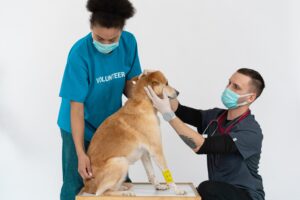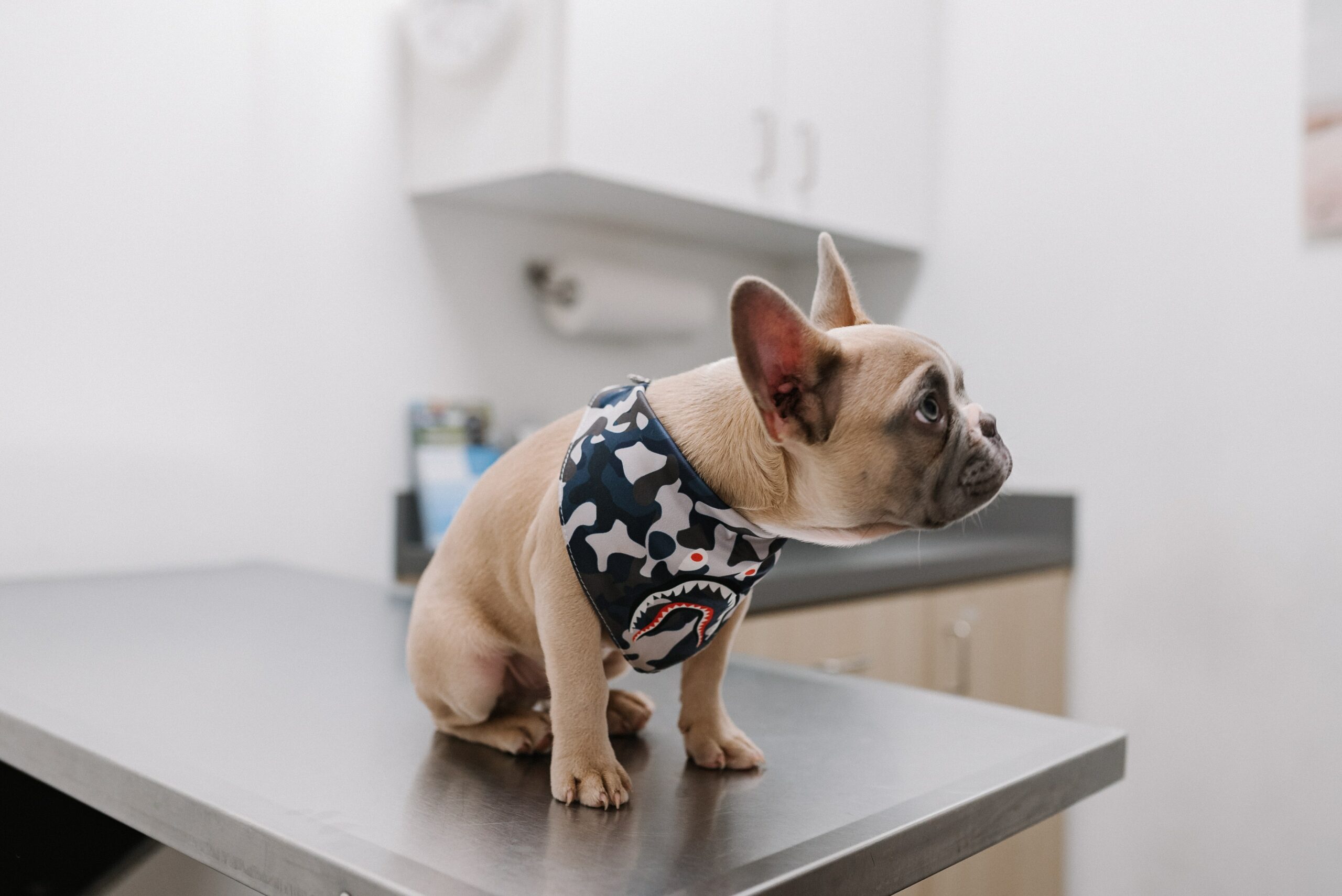Both pets and their parents may experience some anxiety before a trip to the vet. Even on a pleasant trip to the vet, animals can feel a wide range of emotions, which can affect their mood and level of stress every time they need medical care. Most pets will regard a trip to the vet as an attack on their safety and well-being, and as a result, they may react with fear and helplessness. Such feelings can cause intense reactions, much like the “fight or flight” response you might have in a dangerous situation. The prospect of going to the veterinarian, or even just the thought of doing so, can make some pets aggressive or even cause them to run away. That’s why it’s essential to know how to make vet visits less stressful for your dog.
Communicate with Your Veterinarian
It’s really important for you to have a good vet. In case you haven’t found one yet, there are a couple of ways to find one. Talk to them about what worries your dog and what you can do to make the vet’s office more comfortable for him. Show off your dog’s ability to “sit,” “down,” and “stay,” as well as any other commands you’ve taught him. However, it is harder to show your doctor what your dog can do or what it is afraid of. That’s because many doctors don’t let their patients bring their pets into the waiting room.
Ask your vet if you can send in videos to describe your dog. This is a great way to transmit information about signals and difficult situations. If they approve, please respect your vet’s and veterinary assistant’s time by keeping the videos to a minimum. If the staff is unwilling to view these videos, you may not have found the perfect vet for you and your dog.
Stop by the Animal Hospital just to Say Hello to your Pet
Just dropping in from time to time is very much appreciated. Bring your dog in, have him weighed, and go out the door. Simply being in an unknown environment might be unsettling, especially if it’s your dog’s first time there.
This usually occurs after relocating your home. You can make many mistakes when moving with pets, so be aware of these things and try to prevent problems on moving day. Your dog will be less anxious about visiting the vet if you do it regularly since this will help him associate the office with positive experiences. The sooner you start taking your new dog to the vet for “social” checkups, the better. However, if your dog is older or has anxiety about trips to the veterinarian, there’s no need to worry. You can make vet visits less stressful for your dog by engaging in lighthearted social activities.
Talk to your vet ahead of time and tell them what you have planned. Try contacting them and asking when it would be a good time to stop by if you only have a few minutes to spare. Be considerate of the veterinarian’s and staff’s time by scheduling your social visit during a time that works for them. You should also call ahead to ensure there isn’t an emergency or contagious disease they’re dealing with.

Creating a friendly relationship between your dog and the vet is really important.
Distribute a Variety of Delectable Treats
Giving high-quality treats to the staff at the clinic that they would give to your dog will undoubtedly make vet visits less stressful for your dog. There’s a good reason why this is taught in introductory courses like “Love YourVet101”: it helps.
It is possible to improve a dog’s attitude toward trips to the veterinarian by educating them that they will be rewarded with the most delicious goodies in the world. If you want to get the most out of this method, you need to put your attention and effort into the following two areas: To begin with, choose candies that are not commonly found; cookies that have lost their moisture will not have the same effect. Would you rather eat a cracker or a chocolate chip cookie to incentivize you to complete a task? Secondly, you should use a variety of treats to reward your dog. Unless it would somehow be detrimental to his health, this will have a greater impact on his conduct.

Treats are great for improving your dog’s mood.
Play with your Dog’s Mouth to Make Vet Visits Less Stressful for your Dog
The most challenging aspect of our job is dealing with dogs who aren’t used to having their mouths touched. Playing with your dog and regular tooth brushing can help your dog become accustomed to having its mouth handled. As a matter of fact, it’s money well spent. This is good for the dog and the vet. In some cases, it may even increase the time that passes between professional dental cleanings. It could make the difference between putting your dog to sleep for a dental cleaning or not.
As long as you clean their teeth, that’s all that matters! It’s possible that brushing the teeth’s chewing surfaces will have a significant impact if done regularly. Dogs should only use toothpaste made specifically for dogs; human toothpaste should never be used on a dog. Doggie toothpaste comes in various flavors, including chicken, beef, and malt, which may make brushing your dog a more positive experience.
To make vet visits even less stressful for your dog, you can open his lips, peep inside, and then quickly replace the treat. Your dog will eventually realize that mouth-smacking means good things are coming. You can train dogs in many ways. One of them is to enjoy having their mouths petted by massaging the roof of their mouths and gums with a dab of peanut butter, yogurt, or cottage cheese. Your dog will get a new taste and get used to having your fingers in his mouth.

In order for a less stressful vet visit, your dog needs to be comfortable with having his mouth touched.
The Importance of Handling Exercises
It would help if you took your puppy to the vet at least once before bringing it home. Puppy breeders should take their charges to the vet as part of their early socialization program. A dog’s fear of the vet can be significantly lessened if they are taught from a young age that they will be held down and looked at.
Start with the fundamentals of handling. Everyday interactions with a touch-tolerant dog should include a massage, preferably at the end of the day when the dog is tired. There are many ways of cheering up your dog, so we will be going over some of them. Check the paws, ears, lips, belly, and tail just like a real vet would. Be sure to use a lot of positive reinforcement and things like treats and a lot of praise, so your dog associates being handled with nice things. You can make vet visits less stressful for your dog by starting gently and working up to more intense control methods, such as squeezing the paws. Teeth and paws are the most challenging areas to examine in most dogs.

Your dog’s teeth are the most dangerous to be examined, so make sure the dog is relaxed and ready before the checkup.
If your dog is touch-sensitive, be gentle. Desensitization and counterconditioning affect a dog’s emotional response to specific stimuli. Ideally, the recipient would be rewarded after each touch. You can distract a dog with a treat while working on a body part at first. You should touch your calm dog before giving him a treat. The owner may hold the dog’s ear and then treat him. It’s only then that you should touch the ear and offer a goodie. Touch the ear briefly, treat the dog, and repeat until you can lift the ear and peek into the canal. Professionals at Divine Moving and Storage say that they have witnessed this method calming a dog before the move. So it might do the trick when going to the vet, as well.
Having the proper tools while visiting the vet
Bringing the proper supplies to your dog’s vet appointment will make the process much smoother for everyone involved. Get all of your dog’s favorite treats together first. Giving your dog treats during the exam might serve as a distraction and establish positive associations. You can also ask the vet and the rest of the staff to feed a few. You might also want to bring a toy if your dog needs to be distracted during an injection or other unpleasant procedure.
Pheromone treatments or calming treats can make vet visits less stressful for your dog. Adult dogs can be comforted by pheromones since they mirror a mother dog’s milk scent. Try to find a collar or spray that you may use before taking your pet in for treatment. You might give him some calming treats beforehand to help keep them calm. If you want to avoid any feelings of pressure, schedule the meeting for a time when the office isn’t busy. Lastly, if your dog is having trouble keeping medical appointments, discuss other options with your physician. It’s important that they can examine your dog thoroughly without upsetting them too much.
https://unsplash.com/photos/uy5l-VJ8dRM
https://www.pexels.com/photo/a-man-checking-a-brown-down-7474550/
https://unsplash.com/photos/xe_MtM-ixlw
https://www.pexels.com/photo/person-holding-black-and-white-siberian-husky-3671300/
https://unsplash.com/photos/FNC5P2lyxQ8
Love our content? Share it with a friend or link it to social media. Like short clips of cute household pets? Training tips? Follow us on instagram @nydognanny or on YouTube at nydognanny. Have some news you needs to get to dog and cat parents stat? Email info@newyorkdognanny.com with your article pitch.




